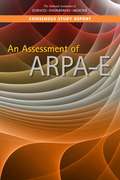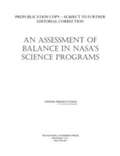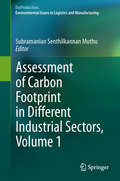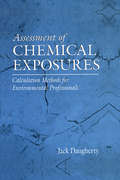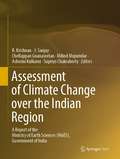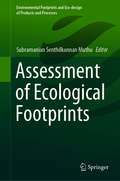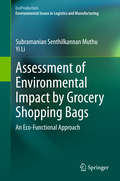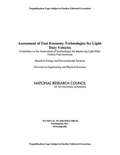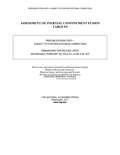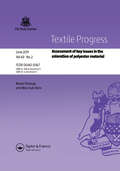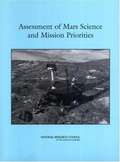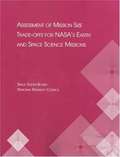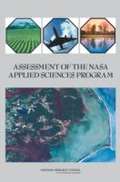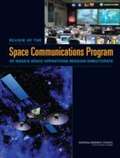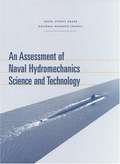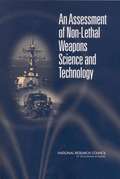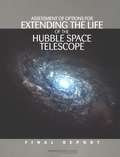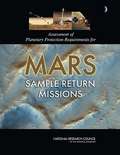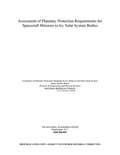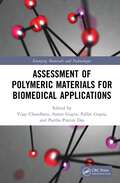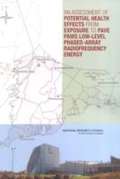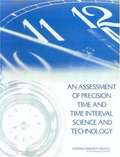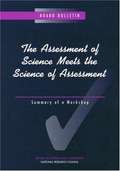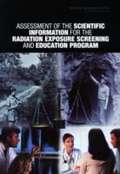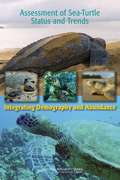- Table View
- List View
An Assessment of ARPA-E
by National Academies of Sciences Engineering MedicineIn 2005, the National Research Council report Rising Above the Gathering Storm recommended a new way for the federal government to spur technological breakthroughs in the energy sector. It recommended the creation of a new agency, the Advanced Research Projects Agency-Energy, or ARPA-E, as an adaptation of the Defense Advanced Research Projects Agency (DARPA) model—widely considered a successful experiment that has funded out-of-the-box, transformative research and engineering that made possible the Internet, GPS, and stealth aircraft. This new agency was envisioned as a means of tackling the nation’s energy challenges in a way that could translate basic research into technological breakthroughs while also addressing economic, environmental, and security issues. Congress authorized ARPA-E in the 2007 America COMPETES Act and requested an early assessment following 6 years of operation to examine the agency’s progress toward achieving its statutory mission and goals. This report documents the results of that assessment. It includes both an operational assessment of the agency’s funding programs and a technical assessment of its awards, to the extent possible.
An Assessment Of Balance In Nasa's Science Programs
by National Research Council of the National AcademiesWhen the space exploration initiative was announced, Congress asked the NRC to review the science NASA proposed to carryout under the initiative. It also asked the NRC to assess whether this program would provide balanced scientific research across the established disciplines supported by NASA in addition to supporting the new initiative. In 2005, the NRC released three studies focusing on a portion of that task, but changes at NASA forced the postponement of the last phase. This report presents that last phase with an assessment of the health of the NASA scientific disciplines under the budget requests imposed by the exploration initiative. The report also provides an analysis of whether the science budget appropriately reflects cross-disciplinary scientific priorities.
Assessment of Carbon Footprint in Different Industrial Sectors, Volume 2 (EcoProduction)
by Subramanian Senthilkannan MuthuFollowed by the previous part (Volume-1), Volume-2 of carbon footprint assessment book deals with the assessment of carbon footprint in different other sectors, which were not dealt in the first part. Attention on Carbon footprint is growing day-by-day from the public, government and media. Certainly it is one of the most important topics in the agenda of every nation, which is trying its best to reduce its carbon footprint to the maximum possible extent. Every manufacturing industry or sector would like to reduce the carbon footprint of its products and consumers are looking for the products which emit lower carbon emissions in their entire life cycle. Assessment of Carbon footprint for different products, processes and services and also carbon labeling of products have become familiar topics in the recent past in various industrial sectors. Every industry has its unique assessment and modeling techniques, allocation procedures, mitigation methods and labeling strategies for its carbon emissions. With this background, volume two of this book has been framed with dedicated chapters on carbon footprint assessment on various industrial sectors, apart from the ones covered in Volume 1. In each chapter, details pertaining to the assessment methodologies of carbon footprint followed in a particular industry, challenges in calculating the carbon footprint, case studies of various products in that particular industry, mitigation measures to be followed to trim down the carbon footprint, recommendations for further research are discussed in detail.
Assessment of Chemical Exposures: Calculation Methods for Environmental Professionals
by Jack E. DaughertyTraditionally, industrial hygienists and environmental engineers have been responsible for conducting chemical exposure assessments, however, this task is now becoming a team effort taken on by scientists, businessmen, and policymakers. Assessment of Chemical Exposures: Calculation Methods for Environmental Professionals addresses the expanding scope of exposure assessments in both the workplace and environment. It discusses the basics of gathering data and assessing exposure, including how to estimate exposure to chemicals using fundamental chemical engineering concepts. The book opens with a brief discussion on the history of exposure assessments and provides terms and nomenclature needed for communications between various disciplines involved in exposure assessments. The potential impact of chemical exposures on humans, the environment, and communities is discussed in detail The book also addresses modeling source generation, pathway transport, and receptor impact. With the clear explanations presented in this text, even a novice will be able to practice the art of exposure assessment.
Assessment of Climate Change over the Indian Region: A Report of the Ministry of Earth Sciences (MoES), Government of India
by R. Krishnan J. Sanjay Chellappan Gnanaseelan Milind Mujumdar Ashwini Kulkarni Supriyo ChakrabortyThis open access book discusses the impact of human-induced global climate change on the regional climate and monsoons of the Indian subcontinent, adjoining Indian Ocean and the Himalayas. It documents the regional climate change projections based on the climate models used in the IPCC Fifth Assessment Report (AR5) and climate change modeling studies using the IITM Earth System Model (ESM) and CORDEX South Asia datasets. The IPCC assessment reports, published every 6–7 years, constitute important reference materials for major policy decisions on climate change, adaptation, and mitigation. While the IPCC assessment reports largely provide a global perspective on climate change, the focus on regional climate change aspects is considerably limited. The effects of climate change over the Indian subcontinent involve complex physical processes on different space and time scales, especially given that the mean climate of this region is generally shaped by the Indian monsoon and the unique high-elevation geographical features such as the Himalayas, the Western Ghats, the Tibetan Plateau and the adjoining Indian Ocean, Arabian Sea, and Bay of Bengal. This book also presents policy relevant information based on robust scientific analysis and assessments of the observed and projected future climate change over the Indian region.
Assessment of Ecological Footprints (Environmental Footprints and Eco-design of Products and Processes)
by Subramanian Senthilkannan MuthuThis book highlights the concepts and assessment methods of Ecological Footprints. Ecological footprint is defined as, ”a measure of how much area of biologically productive land and water an individual, population or activity requires to produce all the resources it consumes and to absorb the waste it generates, using prevailing technology and resource management practices”. Developed in 1992 by William Rees, it was the first footprint developed followed by other footprints such as Carbon, Water and Energy. Assessment of Ecological footprints strive for comparing consumption footprint to biological capacity. This book presents five interesting chapters pertaining to the assessment of Ecological Footprints.
Assessment of Environmental Impact by Grocery Shopping Bags: An Eco-Functional Approach (EcoProduction)
by Yi Li Subramanian Senthilkannan MuthuThis book reviews the manufacturing processes of different shopping bags used for grocery purposes, life cycle impacts, modelling of life cycle impacts, carbon and eco-footprints in different countries, consumption of shopping bags in different countries, consumer behaviour of shopping bags in various countries and its relation to eco-impact, assessment of functionality of shopping bags, concept and framework of eco-functional assessment of shopping bags, biodegradation of shopping bags, etc.
Assessment of Fuel Economy Technologies for Light-Duty Vehicles
by National Research Council of the National AcademiesVarious combinations of commercially available technologies could greatly reduce fuel consumption in passenger cars, sport-utility vehicles, minivans, and other light-duty vehicles without compromising vehicle performance or safety. Assessment of Technologies for Improving Light Duty Vehicle Fuel Economy estimates the potential fuel savings and costs to consumers of available technology combinations for three types of engines: spark-ignition gasoline, compression-ignition diesel, and hybrid. According to its estimates, adopting the full combination of improved technologies in medium and large cars and pickup trucks with spark-ignition engines could reduce fuel consumption by 29 percent at an additional cost of $2,200 to the consumer. Replacing spark-ignition engines with diesel engines and components would yield fuel savings of about 37 percent at an added cost of approximately $5,900 per vehicle, and replacing spark-ignition engines with hybrid engines and components would reduce fuel consumption by 43 percent at an increase of $6,000 per vehicle. The book focuses on fuel consumption--the amount of fuel consumed in a given driving distance--because energy savings are directly related to the amount of fuel used. In contrast, fuel economy measures how far a vehicle will travel with a gallon of fuel. Because fuel consumption data indicate money saved on fuel purchases and reductions in carbon dioxide emissions, the book finds that vehicle stickers should provide consumers with fuel consumption data in addition to fuel economy information.
Assessment of Inertial Confinement Fusion Targets
by National Research Council Board on Physics and Astronomy Division on Engineering and Physical Sciences Panel on the Assessment of Inertial Confinement Fusion Targets Board on Energy and Environmental SystemsIn the fall of 2010, the Office of the U.S. Department of Energy's (DOE's) Secretary for Science asked for a National Research Council (NRC) committee to investigate the prospects for generating power using inertial confinement fusion (ICF) concepts, acknowledging that a key test of viability for this concept--ignition --could be demonstrated at the National Ignition Facility (NIF) at Lawrence Livermore National Laboratory (LLNL) in the relatively near term. The committee was asked to provide an unclassified report. However, DOE indicated that to fully assess this topic, the committee's deliberations would have to be informed by the results of some classified experiments and information, particularly in the area of ICF targets and nonproliferation. Thus, the Panel on the Assessment of Inertial Confinement Fusion Targets ("the panel") was assembled, composed of experts able to access the needed information. The panel was charged with advising the Committee on the Prospects for Inertial Confinement Fusion Energy Systems on these issues, both by internal discussion and by this unclassified report. A Panel on Fusion Target Physics ("the panel") will serve as a technical resource to the Committee on Inertial Confinement Energy Systems ("the Committee") and will prepare a report that describes the R&D challenges to providing suitable targets, on the basis of parameters established and provided to the Panel by the Committee. The Panel on Fusion Target Physics will prepare a report that will assess the current performance of fusion targets associated with various ICF concepts in order to understand: 1. The spectrum output; 2. The illumination geometry; 3. The high-gain geometry; and 4. The robustness of the target design. The panel addressed the potential impacts of the use and development of current concepts for Inertial Fusion Energy on the proliferation of nuclear weapons information and technology, as appropriate. The Panel examined technology options, but does not provide recommendations specific to any currently operating or proposed ICF facility.
Assessment of Key Issues in the Coloration of Polyester Material (Textile Progress Ser.)
by Renzo ShameyThis book addresses the problems in the dyeing of polyester textile materials in various forms and provides an overview of various textile operations for polyester. It presents various key steps and critical factors involved in the production of dyed polyester textile materials.
Assessment of Mars Science and Mission Priorities
by Committee on Planetary Lunar ExplorationAn Assessment of Mars Science and Mission Priorities
Assessment Of Mission Size Trade-offs For Nasa's Earth And Space Science Missions
by Ad Hoc Committee on the Assessment of Mission Size Trade-offs for Earth Space Science MissionsThe National Academies Press (NAP)--publisher for the National Academies--publishes more than 200 books a year offering the most authoritative views, definitive information, and groundbreaking recommendations on a wide range of topics in science, engineering, and health. Our books are unique in that they are authored by the nation's leading experts in every scientific field.
Assessment Of The Nasa Applied Sciences Program
by National Research Council of the National AcademiesRemote sensing data and models from the National Aeronautics and Space Administration (NASA) are the basis for a wide spectrum of scientific research endeavors and are key inputs to many public and private services. The NASA Applied Sciences Program (ASP) and its precursors have been tasked with ensuring the extension of NASA Earth observation data and associated research into practical applications for society through external partnerships. With approximately five years having elapsed under the current ASP structure, and a growing government-wide emphasis on societal benefits in its Earth observing programs, NASA and the ASP leadership asked the National Research Council to assess ASP's approach in extending NASA research results to practical, societal applications. The report recommends that ASP partnerships should focus not only federal agencies but alsoon direct engagement of the broader community of users. The report also recommends that ASP enhance communication and feedback mechanisms with its partners, with the end users and beneficiaries of NASA data and research, and with the NASA organization.
Assessment of NASA's Mars Architecture 2007-2016
by National Research Council of the National AcademiesThe National Academies Press (NAP)--publisher for the National Academies--publishes more than 200 books a year offering the most authoritative views, definitive information, and groundbreaking recommendations on a wide range of topics in science, engineering, and health. Our books are unique in that they are authored by the nation's leading experts in every scientific field.
An Assessment of Naval Hydromechanics Science and Technology
by Naval Studies Board National Research CouncilAn Assessment of Naval Hydromechanics Science and Technology
An Assessment of Non-Lethal Weapons Science and Technology
by Technology Committee for an Assessment of Non-Lethal Weapons ScienceNon-lethal weapons (NLWs) are designed to minimize fatalities and other undesired collateral damage when used. Events of the last few years including the attack on the USS Cole have raised ideas about the role NLWs can play in enhancing support to naval forces. In particular to what extent and in what areas should Department of the Navy (DoN) -sponsored science and technology (S&T) provide a research base for developing NLW capabilities? To assist with this question and to evaluate the current NLWs program, the Joint Non-Lethal Weapons Directorate (JNLWD) and the Office of Naval Research (ONR) requested the National Research Council perform an assessment of NLWs science and technology. The report presents the results of that assessment. It discusses promising NLW S&T areas, development accomplishments and concerns about NLW, and series of recommendations about future NLW development and application.
ASSESSMENT OF OPTIONS FOR EXTENDING THE LIFE OF THE HUBBLE SPACE TELESCOPE: Final Report
by National Research Council of the National AcademiesThe Hubble Space Telescope (HST) has operated continuously since 1990. During that time, four space shuttle-based service missions were launched, three of which added major observational capabilities. A fifth — SM-4 — was intended to replace key telescope systems and install two new instruments. The loss of the space shuttle Columbia, however, resulted in a decision by NASA not to pursue the SM-4 mission leading to a likely end of Hubble’s useful life in 2007-2008. This situation resulted in an unprecedented outcry from scientists and the public. As a result, NASA began to explore and develop a robotic servicing mission; and Congress directed NASA to request a study from the National Research Council (NRC) of the robotic and shuttle servicing options for extending the life of Hubble. This report presents an assessment of those two options. It provides an examination of the contributions made by Hubble and those likely as the result of a servicing mission, and a comparative analysis of the potential risk of the two options for servicing Hubble. The study concludes that the Shuttle option would be the most effective one for prolonging Hubble’s productive life.
Assessment of Planetary Protection Requirements for MARS: SAMPLE RETURN MISSIONS
by National Research Council of the National AcademiesNASA maintains a planetary protection policy to avoid the forward biological contamination of other worlds by terrestrial organisms, and back biological contamination of Earth from the return of extraterrestrial materials by spaceflight missions. Forward-contamination issues related to Mars missions were addressed in a 2006 National Research Council (NRC) book, Preventing the Forward Contamination of Mars. However, it has been more than 10 years since back-contamination issues were last examined. Driven by a renewed interest in Mars sample return missions, this book reviews, updates, and replaces the planetary protection conclusions and recommendations contained in the NRC's 1997 report Mars Sample Return: Issues and Recommendations. The specific issues addressed in this book include the following: The potential for living entities to be included in samples returned from Mars; Scientific investigations that should be conducted to reduce uncertainty in the above assessment; The potential for large-scale effects on Earth's environment by any returned entity released to the environment; Criteria for intentional sample release, taking note of current and anticipated regulatory frameworks; and The status of technological measures that could be taken on a mission to prevent the inadvertent release of a returned sample into Earth's biosphere.
Assessment of Planetary Protection Requirements for Spacecraft Missions to Icy Solar System Bodies
by Space Studies Board National Research Council Division on Engineering and Physical Sciences Committee on Planetary Protection Standards for Icy Bodies in the Outer Solar SystemNASA's exploration of planets and satellites during the past 50 years has led to the discovery of traces of water ice throughout the solar system and prospects for large liquid water reservoirs beneath the frozen ICE shells of multiple satellites of the giant planets of the outer solar system. During the coming decades, NASA and other space agencies will send flybys, orbiters, subsurface probes, and, possibly, landers to these distant worlds in order to explore their geologic and chemical context. Because of their potential to harbor alien life, NASA will select missions that target the most habitable outer solar system objects. This strategy poses formidable challenges for mission planners who must balance the opportunity for exploration with the risk of contamination by Earth's microbes, which could confuse the interpretation of data obtained from these objects. The 2000 NRC report Preventing the Forward Contamination of Europa provided a criterion that was adopted with prior recommendations from the Committee on Space Research of the International Council for Science. This current NRC report revisits and extends the findings and recommendations of the 2000 Europa report in light of recent advances in planetary and life sciences and, among other tasks, assesses the risk of contamination of icy bodies in the solar system.
Assessment of Polymeric Materials for Biomedical Applications (Emerging Materials and Technologies)
by Vijay Chaudhary Sumit Gupta Pallav Gupta Partha Pratim DasThis book initiates with an introduction to polymeric materials, followed by various classifications and properties of polymeric implant material including various development methods of polymeric materials and their characterization techniques. An overview of various toxicology assessments of polymeric materials and polymeric materials for drug delivery system is also included. Design and analysis of polymeric materials-based components using Ansys software along with polymeric materials for additively manufactured artificial organs are also discussed. Features: Addresses assessment of polymeric materials in biomedical sciences, including classification, properties, and development of polymeric implants. Covers various topics in the field of tissue regeneration. Discusses biocompatibility, toxicity, and biodegradation of polymeric materials. Explores wide-scale characterization to study the effect of inclusion size on the mechanical properties of polymeric materials. Reviews limitations and future directions on polymeric material with emphasis on biocompatibility. This book is aimed at graduate students and researchers in biomaterials, biomedical engineering, composites, and polymers.
An Assessment Of Potential Health Effects From Exposure To Pave Paws Low-level Phased-array Radiofrequency Energy
by National Research Council of the National AcademiesPAVE PAWS is a phased-array warning system designed to detect and track sea-launched and intercontinental ballistic missiles operated on Cape Cod since 1979 by the U.S. Air Force Space Command. In 1979, the National Research Council issued two reports to address concerns from Cape Cod residents about the safety and possible health effects of the radiofrequency energy from the radar. Following up on the1979 report, the new report finds no evidence of adverse health effects to Cape Cod residents from long-term exposure to the PAVE PAWS radar. The report specifically investigated whether the PAVE PAWS radar might be responsible in part for the reported higher rates of certain cancers in the area, but concludes there is no increase in the total number of cancers or in specific cancers of the prostate, breast, lung, or colon due to radiation exposure from PAVE PAWS. The report did find in the scientific literature a few biological responses to radiofrequency exposures that were statistically significant. Such responses do not necessarily result in adverse health effects, but the report recommends additional studies to better discern the significance, if any, of those findings.
An Assessment Of Precision Time And Time Interval Science And Technology
by Technology Committee for an Assessment of Precision Time Time Interval ScienceAn Assessment Of Precision Time And Time Interval Science And Technology
The Assessment of Science Meets the Science of Assessment: Summary of a Workshop
by Board On Testing AssessmentThe National Academies Press (NAP)--publisher for the National Academies--publishes more than 200 books a year offering the most authoritative views, definitive information, and groundbreaking recommendations on a wide range of topics in science, engineering, and health. Our books are unique in that they are authored by the nation's leading experts in every scientific field.
Assessment Of The Scientific Information For The Radiation Exposure Screening And Education Program
by National Academy of Sciences of the National AcademiesThe Radiation Exposure Compensation Act (RECA) was set up by Congress in 1990 to compensate people who have been diagnosed with specified cancers and chronic diseases that could have resulted from exposure to nuclear-weapons tests at various U. S. test sites. Eligible claimants include civilian onsite participants, downwinders who lived in areas currently designated by RECA, and uranium workers and ore transporters who meet specified residence or exposure criteria. The Health Resources and Services Administration (HRSA), which oversees the screening, education, and referral services program for RECA populations, asked the National Academies to review its program and assess whether new scientific information could be used to improve its program and determine if additional populations or geographic areas should be covered under RECA. The report recommends Congress should establish a new science-based process using a method called "probability of causation/assigned share" (PC/AS) to determine eligibility for compensation. Because fallout may have been higher for people outside RECA-designated areas, the new PC/AS process should apply to all residents of the continental US, Alaska, Hawaii, and overseas US territories who have been diagnosed with specific RECA-compensable diseases and who may have been exposed, even in utero, to radiation from U. S. nuclear-weapons testing fallout. However, because the risks of radiation-induced disease are generally low at the exposure levels of concern in RECA populations, in most cases it is unlikely that exposure to radioactive fallout was a substantial contributing cause of cancer.
Assessment of Sea-Turtle Status and Trends: Integrating Demography and Abundance
by National Research Council of the National AcademiesAll six species of sea turtles found in U.S. waters are listed as endangered or threatened, but the exact population sizes of these species are unknown due to a lack of key information regarding birth and survival rates. The U.S. Endangered Species Act prohibits the hunting of sea turtles and reduces incidental losses from activities such as shrimp trawling and development on beaches used for nesting. However, current monitoring does not provide enough information on sea turtle populations to evaluate the effectiveness of these protective measures. Sea Turtle Status and Trends reviews current methods for assessing sea turtle populations and finds that although counts of sea turtles are essential, more detailed information on sea turtle biology, such as survival rates and breeding patterns, is needed to predict and understand changes in populations in order to develop successful management and conservation plans.
